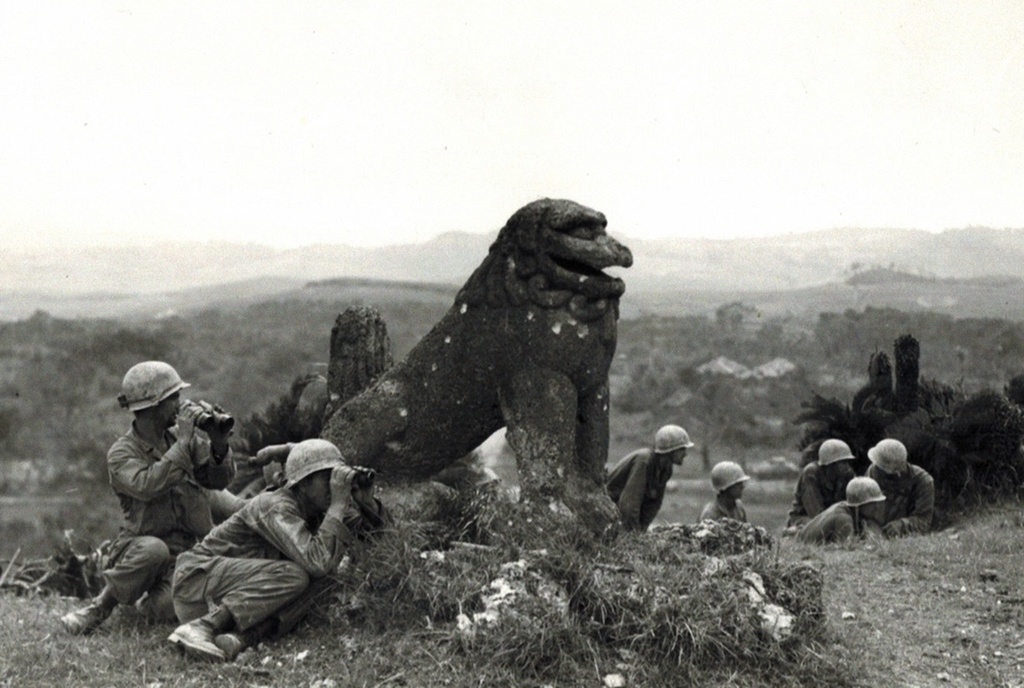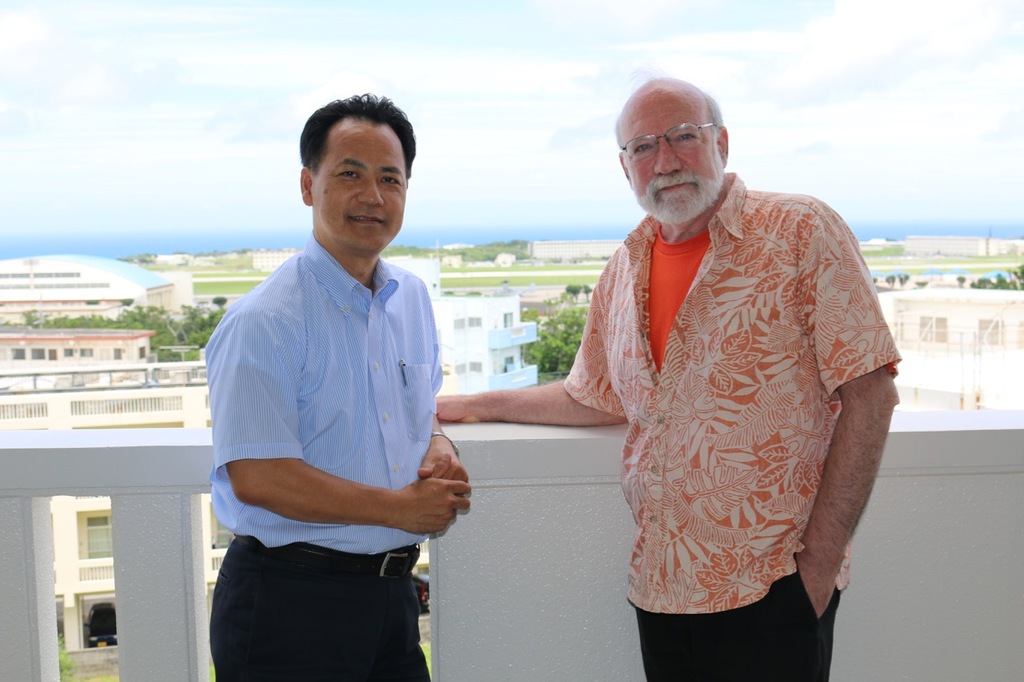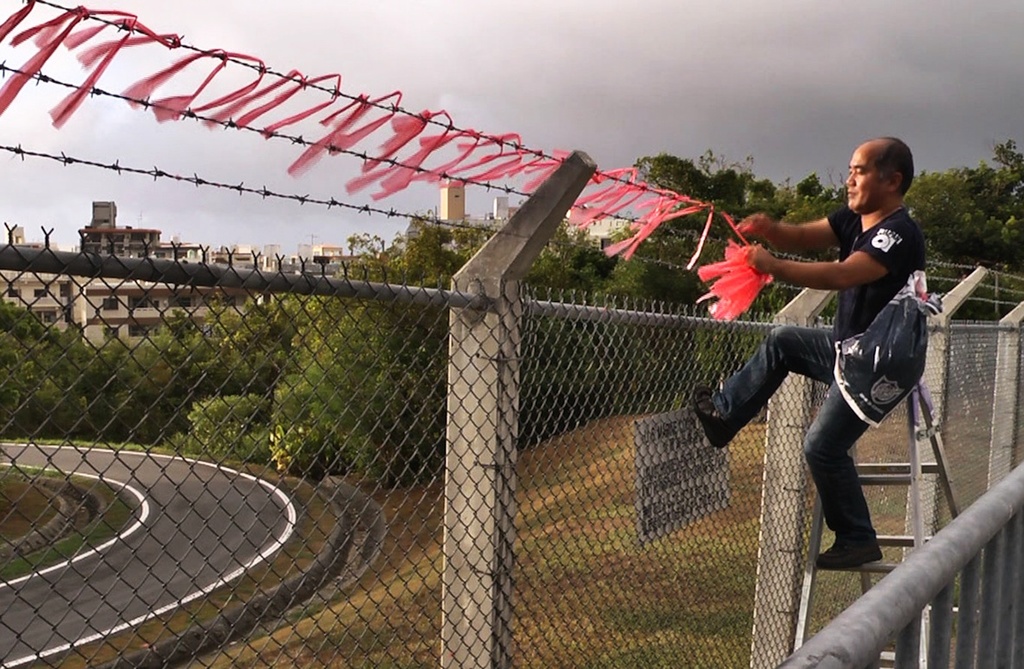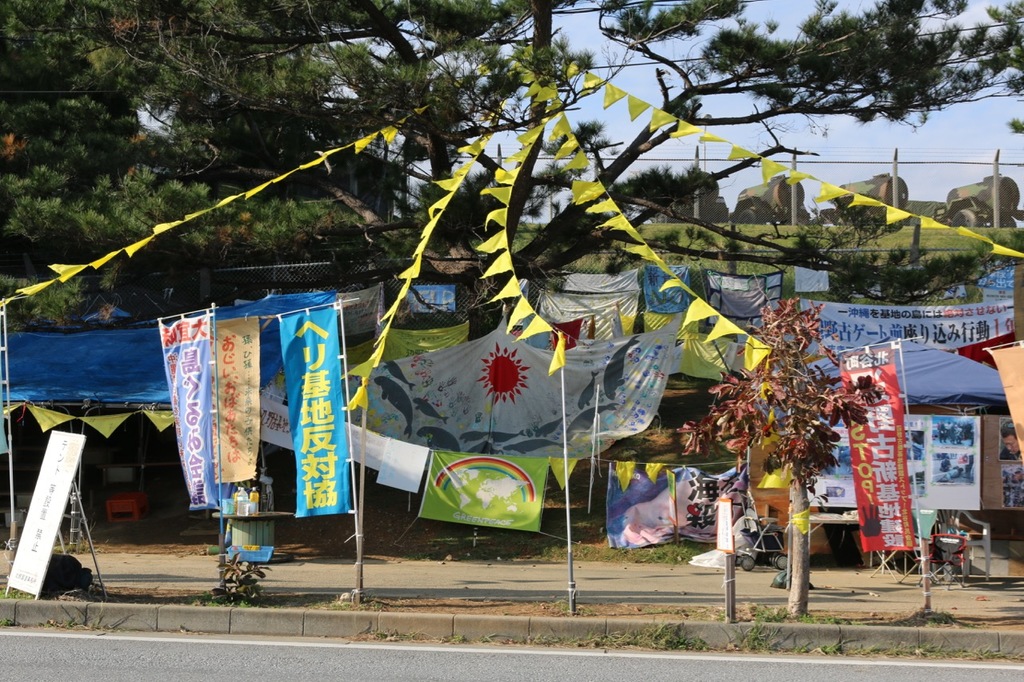John Junkerman (JJ): I want to hear your thoughts about the history and policies that lie behind the present situation of the US bases on Okinawa, but first, could you tell us what you thought of our film? You watched the Japanese version, Okinawa: Urizun no Ame, and we included an interview with you in the American version.
Maedomari Hiromori (MH): As a journalist, I was impressed by how the reality of the Battle of Okinawa and postwar history emerge from the patient accumulation of eyewitness accounts. The testimony of the American veterans of the Battle of Okinawa gave me a new awareness. When we talk of war, we usually see it in terms of “enemies and allies,” but in fact there are no enemies or allies. This film forcefully expresses how soldiers on both sides are the victims of war. The American soldiers were equally terrified of combat, suffered casualties, lost many lives, and were left with deep spiritual wounds. How do soldiers and civilians experience armed conflict? And after the war ends, people continue to suffer the consequences. Once your spirit has been damaged, it is difficult to recover. As former Okinawa governor Ota Masahide says in the film, “The Battle of Okinawa never ended. It continues today.” That left a strong impression.
JJ: The English title of the film is “Okinawa: The Afterburn.” “Afterburn” is not a common English expression, but one of its meanings is that a burn continues to deepen after the flame is extinguished. As a psychological phenomenon, the damage from a trauma continues to deepen until the source of that trauma is resolved.
MH: That captures it well. It’s a very good title.
 |
Okinawa: Island of Bases, Forgotten Island
JJ: The US military started building bases on Okinawa while the Pacific War was still being fought, in preparation for the invasion of mainland Japan. But after the war, when they were no longer necessary for that purpose, the US retained and expanded the bases.
MH: The American bases were built in preparation for the invasion of the mainland, on land that the US occupied during the Battle of Okinawa. After the war, these became strategic bases used as a staging area and airbase for bombing attacks during the wars in Korea and Vietnam. And the bases remain today a military stronghold in the global American strategic posture. After the San Francisco Peace Treaty came into effect in 1952, Okinawa was separated from the mainland and continued under occupation. Japan’s non-nuclear policies did not apply, so the US was able to place nuclear missiles in Okinawa and reinforce the island’s strategic role. During the 1950s, strong anti-base movements in mainland Japan forced the closing of numerous bases, which were then moved to Okinawa, including Marine bases in Gifu and Yamanashi prefectures.
Okinawa’s geographic position at the center of East Asia also led to its use as the “keystone of the Pacific,” where the US based strategic bombers. Under the US-Japan Security Treaty, Japan was required to provide land and facilities for US military forces, which it did by maintaining the bases on Okinawa. As long as the bases remained in Okinawa, the US was satisfied. So the bases have been retained in order to strike this kind of political balance.
JJ: The US has a sense of privileged status in Okinawa, while Japan has reinforced this status through discriminatory treatment of Okinawa.
MH: Another consideration that is often raised is the “deterrent effect” of the US-Japan Security Treaty. According to this view, the stationing of 24 Osprey aircraft at the Marine airbase in Okinawa beginning in October 2012 should have strengthened deterrence. However, the US military presence in Japan and Okinawa has had no deterrent effect against Chinese claims on the Senkaku Islands. Rather, Chinese assertiveness has only increased in recent years. What this means is that military force does not serve as a deterrent in territorial disputes, and it is incapable of delivering drastic solutions. The Senkaku problem is a typical demonstration of these limitations. In the face of this, why does Japan continue to have such high expectations of military force?
From the Okinawan perspective, military affairs and their rationale have shifted over time, while the military presence has continued. In economic terms, the main industry in Okinawa before the war was agriculture, but farmland was seized for the US bases, and the population was forced to depend on the bases for employment. Further, where Japan enjoyed a favorable fixed exchange rate of 360 yen to the US dollar until 1971, US-administered Okinawa used the B yen, valued at 120 to the dollar. This put export-oriented producers at an extreme disadvantage, and resulted in a structural dependence on the base economy. These were really criminal economic policies, in my view.
JJ: But the bases did employ large numbers of people in the 1950s, so people cite this as a boost to the Okinawan economy.
MH: Farmers who lost their land to the bases had no choice but to work on those bases. While Okinawan civilians were kept in detention camps after the war, bases were constructed, so when they were released and returned to their villages, they had no homes. They had no land, no fields. At the end of the war, more than half of the main island of Okinawa was confiscated by the US military; (the bases were later consolidated, but they still occupy 18 percent of the main island). When the occupation of Japan ended in 1952, residents began to demand the return of their land, and the military countered with a plan to buy the occupied land with a one-time payment [in place of the rents then being paid]. A fierce opposition movement erupted. “We’ll never sell our land to the military,” they declared. Despite being exhausted and impoverished by the war, Okinawan people at that time mounted a strong opposition to the bases, and prevented their land from coming under the permanent control of the military.
JJ: That was the beginning of the first Shimagurumi Toso (“island-wide struggle”), which continued through the 1950s. We’re now in the midst of the second Shimagurumi Toso, the campaign to close the US Marine Corps bases, in particular. It can be said that the anti-base movement originated with economic and social causes. There was also pacifist opposition to the military use of their land, but the two motives were deeply intertwined.
MH: Okinawa International University opened in 1972, the “reversion year” when administration of Okinawa was returned from the US military to Japan. What did the people of the city of Ginowan expect to come from building a university? Of course, they expected it to boost economic development, but I’ve heard that there was also a strong expectation that “law and order would improve if a university comes.” The number of crimes committed by American soldiers in Okinawa before reversion was astounding. This was during the Vietnam War and the Korean War before that, so, to the Americans, it was wartime. There was fear that soldiers would lose their fighting spirit if they were severely restricted, so a certain degree of behavior was tolerated. That “certain degree” translated into a tragedy for Okinawa. In the early postwar, the American journalist Frank Gibney wrote a magazine story, “Okinawa: Forgotten Island,” that reported on the cruel and overbearing occupation policies of the American military in great detail.
JJ: “Forgotten Island” appeared in Time magazine in 1949. Despite the heavy military presence in Okinawa, the American public paid little attention and the military operated without much oversight. That was already true then, and 67 years later, the same can still be said about Okinawa. In fact, the Battle of Okinawa is sometimes referred to as “the forgotten battle,” since it is not widely recognized among Americans. The US suffered more casualties in Okinawa than in any other battle of the Pacific War, but the Battle of Normandy is much better known. This lack of awareness is related to the current conditions that Okinawa faces.
MH: Today, as in the past, Okinawa is an island that is absent from memory and awareness. More than being “forgotten,” it may be a case that was never “remembered” in the first place.
 |
The Transition to Economic Bases, and a New Form of Security
MH: My specialization is the analysis of base economics and military economics. In my lectures and essays, I stress that it is important to make a shift from “military bases” to “economic bases.” I believe the problem of the return of Marine Corps Air Station Futenma is a fake problem. I get criticized for saying this, but what I mean is that it is a low priority from an economic standpoint. The risk from training there, the noise, accidents, and crime make Futenma an extremely dangerous base that I’d like to see eliminated as soon as possible. However, in terms of economic rationality and post-return economic effect, the return of Kadena airbase would have a larger and more important impact than Futenma. If Kadena is returned, it could be put to use immediately, but that’s not true of Futenma.
JJ: Why is that?
MH: Because Futenma doesn’t have a clear zone [under the approach to its runway], which makes it unsuited for use as an airport. If Japanese aviation laws were applied, Futenma could not be used as an airport. To use it, the land would have to be cleared, undergo an environmental cleanup, and a reuse plan would have to be developed with the consent of those who own the land. It would require great expenditures and a long period of time to prepare it for reuse. But Kadena has two 4,000-meter runways and twice the amount of land as Narita International Airport, 1.5 times as much functional space. It is one of the largest airports in Japan, as well as in all of Asia. It could be used tomorrow if it were returned today. It is estimated that civilian use of Kadena could create economic activity worth one trillion yen (US $10 billion) annually.
 |
JJ: But the US will never return Kadena.
MH: Everyone thinks they won’t. Because it’s the “spoils of war,” paid for with American blood. But that doesn’t mean anything to the people of Okinawa. Priority should be given to how our own island, our own land can best be used to contribute to economic development. There are two runways at Kadena. We could begin by allowing civilian aircraft to use one of them, that is, “military-civilian joint use” of the base. For example, the US Misawa airbase [in northern Japan] is a joint use base; and MCAS Iwakuni, jointly used by the Marines and the Japanese Maritime Self-Defense Force, has been used since 2013 by All Nippon Airways as well. Both of those airfields have only one runway. Kadena has two. In 2013, the airfield had 60,000 takeoffs and landings; in 2014, the number was 45,000. Naha International Airport has one runway, with 150,000 flights yearly. So Kadena is vastly underutilized, with the expenses for its operations paid by Japanese taxpayers. People might counter that it’s required in case of a crisis, but the joint-use Naha airport is available in a crisis, as are all of the airports on Okinawa’s outlying islands. In strategic terms, there’s simply no reason that Kadena needs to be reserved for exclusive military use during peacetime.
JJ: Does the US military resist reasonable proposals like this because the Kadena airbase would be heavily used if another war broke out in Asia? At the peak of the Vietnam War, they say that aircraft were taking off from Kadena at the rate of one every three minutes. Do supply bases such as Camp Kinzer continue to occupy much more land than is necessary because they might be needed to fight a major war?
MH: The question is, how long will they continue to make these preparations? Humanity has come a long way into the modern age and gained a great deal of knowledge. There are lessons to learn from the history of repeated wars. Why do we continue to depend on military force? The major industrialized countries need to look back at the history of past wars and learn those lessons. How long will we continue to pay massive sums of money for bases that are devoted to killing? Today, 70 years after the war, the military-industrial complex that troubled President Eisenhower so much still controls the American economy and creates a nation that cannot exist without continuing to fight wars. How can the US free itself from its dependence on military industry, from the military-dependent economy? In fact, Okinawa’s efforts to extricate itself from the base- and military-economy can provide a formula for dealing with the same problems that plague the American economy. Changing Okinawa from a military base to an economic base is also a way of contributing to the Asian economy and the world economy. I believe this will be an opportunity to create a new form of security.
Two Myths about Okinawa
MH: I am often asked, “How can Okinawa manage without the bases?” But the American bases now only contribute about 5% of the total Okinawan economy, ¥200 billion (about $2 billion) out of a total of ¥4 trillion (about $40 billion). The world as whole has entered an era of national security that is no longer dependent on the military or military bases. The European Union is an example. There are no wars now in Europe. With the advent of the EU, a community of shared fate has been created, and no one stands to gain from fighting a war in that region. Rather, the losses would be heavy. We can create an Asian Union (AU). If we create an AU community of shared fate, conflict and war in the region would lose their meaning. Therein lies the importance of eliminating the base economy. Military bases do not create wealth. They only create threat, destruction, and killing.
JJ: That’s certainly true.
MH: I want to point out how uneconomical the bases are. For example, the economic effect of the Futenma airbase is about ¥24 million ($240,000) per hectare. Just outside the fence around the base, in the city of Ginowan, that figure is more than ¥80 million ($800,000) per hectare. The civilian economy is already nearly four times as productive. It leaves you with the impression that, within the fences, there is undeveloped land that has been left behind by the progress of time. There has long been opposition to the bases because of base-related accidents, pollution, and crime, but now there is a conspicuous gap between the bases and the outside economy, and people have begun to say that the bases should be eliminated for economic reasons.
JJ: Over the last decade or so, you and others have been making the case that the bases contribute far less to Okinawa than is usually assumed. Nonetheless, two myths persist, that the removal of the bases will damage the Okinawan economy, and that it will jeopardize peace in Japan and Okinawa.
MH: One aspect of the problem is the gap between those who benefit from the bases and those who are victimized by them. These are two distinct groups. Those who own land inside the fences receive annual payments of rent (paid by the Japanese government). There are 43,228 owners of military-use property, and the total annual rent payment is about ¥83 billion ($830 million). This income averages ¥2 million ($20,000) per landowner annually; this amount is the same as the average annual income in Okinawa. Also, there are 8,800 people who work on the bases, and there are companies that profit from base-related business. These people do not advocate the elimination of the bases. Given that context, how do you break the spell of the base economy? It’s not an easy task.
JJ: What do you think is the best way to get people with divergent interests to understand the importance of divesting Okinawa of the bases?
MH: The private sector economy in Okinawa has now become very powerful, and the uneconomical nature of the military bases has become conspicuously visible. In areas where base land has been returned, such as Chatan (in central Okinawa) or Naha’s new city center and the Kanagusuku district, the reuse of this land has increased economic benefits 10 times and even 100 times that of their prior military use. It may be bad news to those who want to keep the bases and impose them on Okinawa, but there has not been a single instance of failure in the reuse of returned military land in Okinawa. There is a parcel in West Futenma that is slated for return, and the plan is to build one of Asia’s leading medical treatment centers there. If the vast expanse of the US base land is returned, that holds the potential for the realization of an array of Asian dreams.
JJ: Okinawa holds great significance, not only domestically for Japan, but for Asia as a whole.
MH: Former Defense Minister Morimoto Satoshi sparked controversy when he said something to the effect that “There is no strategic reason to have the bases in Okinawa; they are kept there for political reasons.” The development of missiles and nuclear weapons has eliminated the geographical advantage that Okinawa offered militarily. But Okinawa’s geographical advantage has drawn the attention of private-sector companies from China, Malaysia, Singapore and elsewhere, and they are developing plans to use Okinawa as an airfreight hub for the distribution of goods and as a base for the tourism industry. So there are voices being raised saying that “It’s a waste to keep Kadena airport for exclusive military use,” and “Let’s do business that’s more profitable.”
Making Okinawa an economic base would also contribute to American national security. This is not limited to Kadena. The Navy Hospital could become a center for disaster relief, and the military ports, warehouses, and maintenance facilities could all become bases for economic activities. If that were to happen, the American presence in Asia would be deeply appreciated.
JJ: There are great possibilities in that regard.
MH: In discussions of military security, “economic security” tends to get short shrift. In the resolution of military conflicts, there are winners and losers. But in economic security, win-win relationships take priority. Economics can create winners without producing losers. I’d like to see us move into an era of win-win economic security.
 |
Removing the Bases from Okinawa is a Prescription for America
JJ: What do you think the near-term future holds for Okinawa?
MH: The time to reassess the American bases in Okinawa has arrived. The US has agreed to return five bases located south of Kadena if Japan builds the new base in Henoko. This includes the military port in Naha, Camp Kinzer (the Makiminato logistics area), Futenma airbase, Camp Zukeran, and Camp Kuwae, along with a small Army oil storage facility (so, to be precise, that’s six bases). These are no longer needed, so they will be returned, they say. But if they admitted outright that they don’t need them, they’d get nothing in exchange, so they made the return of the five bases contingent on Japan building the new base in Henoko. But if you look closely at the agreement, they’re demanding replacement facilities for all five bases.
JJ: So it’s a “return” in name only.
MH: They’ll return bases they’ve used for 70 years and are now decrepit, and replace then with cutting-edge new facilities. They’re tying all this to the return of the Futenma base, with the Japanese government bearing all of the cost. That’s very adept negotiation by the US at the expense of Japan and Okinawa. The new base at Henoko will function as a military port, it will have maintenance facilities and provide logistics (storage and supply) functions, in addition to the airfield. Nearby is the Henoko ammunition depot [now part of Camp Schwab], where the US stored nuclear missiles in the past. This full-spectrum, cutting-edge facility will be delivered into US hands at no cost. The US feints the “return of Futenma,” and the Japanese government falls for it. Other functions will be moved to other bases, where new facilities will be built. For the most part, the Japanese people, who will pay most of the cost through their taxes, say “Why does Okinawa resist this?” and support the move and the new facility. No one seems to notice the contradictions.
Are the US bases, including the new base in Henoko, really necessary, are they performing a useful role? Why isn’t this thoroughly examined? It’s astounding. Okinawa is aiming to build an economy that will function without the American bases. If we are successful, this will provide a prescription for the American economy, which is heavily addicted to military spending, to extract itself from the military base economy. Witnessing Okinawa free itself from dependence on the bases, Americans will become aware of the spell they are under in their own base-dependent economy. Then Okinawa will become “the unforgettable island” in the eyes of the Americans. That’s what I think.
JJ: Ha-ha, “the unforgettable island.” I like that. Thank you for your many valuable insights.
 |
MAEDOMARI Hiromari
After finishing graduate school at Meiji University, Maedomari began work as a reporter at Ryukyu Shimpo in Okinawa in 1984. He worked in a number of bureaus before joining the editorial committee in 1998. Beginning that year, he taught part-time at universities in Okinawa and Kyushu, while serving as chief editorial writer and in other positions at the newspaper. He became a fulltime professor at Okinawa International University in 2011. He is the author of many books, including Motto shiritai! Honto no Okinawa (I Want to Know More! The Real Okinawa); Kensho Chii Kyotei: Nichi-Bei fubyodo no genryu (Examining the Status of Forces Agreement: The Source of Inequality between Japan and the US); and Honto wa Kenpo yori taisetsu na Nichi-Bei Chii Kyotei Nyumon (Introduction to the US-Japan Status of Forces Agreement: Actually More Important than the Constitution).



